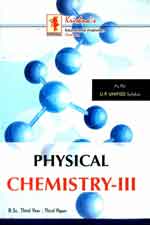|
बी एस-सी - एम एस-सी >> फिजिकल केमिस्ट्री-III (बी.एस-सी.-III पेपर-III) फिजिकल केमिस्ट्री-III (बी.एस-सी.-III पेपर-III)डॉ. आलोक बरियारडॉ. सुधा गोयल
|
5 पाठक हैं |
||||||
विभिन्न विश्वविद्यालयों के बी.एस.सी. के तृतीय वर्ष के रसायन विज्ञान के यू.पी. यूनीफाइड पाठ्यक्रमानुसार
|
|||||
भौतिक रसायन
As per U.P. UNIFIED Syllabus for B.Sc. III year students of All Colleges affiliated to Universities in Uttar Pradesh
विभिन्न विश्वविद्यालयों के बी.एस.सी. के तृतीय वर्ष के रसायन विज्ञान के यू.पी. यूनीफाइड पाठ्यक्रमानुसार
Detailed Contents
1 : Introductory Quantum Mechanics ... 01-28
1.1 Introduction ... 03
1.2 Black Body Radiation ... 04
1.2.1 Stefan Boltzmann Law ... 05
1.2.2 Wien's Displacement Law ... 05
1.2.3 Planck's Quantum Theory ... 06
1.3 Photo Electric Effect ... 08
1.3.1 Mathematical Treatment to Photo Electric Effect ... 08
1.3.2 Specific heat of Solids ... 10
1.3.3 Bohr's Model of an Atom ... 11
1.4 Hydrogen Spectrum ... 16
1.4.1 Genesis of Hydrogen Spectrum ... 17
1.5 Compton Effect or Scattering ... 21
1.6 Sinusoidal Wave ... 23
1.7 Dual Character of Electron ... 24
1.7.1 Derivation of de Broglie Equation ... 24
1.7.2 Derivation of Angular Momentum from de Broglic Equation ... 25
1.8 Heisenberg's Uncertainty Principle ... 27
1.8.1 Explanation of Heisenberg's Uncertainty Principle ... 27
2 : Elementary Spectroscopy ... 29-36
2.1 Introduction ... 29
2.2 Electromagnetic Radiation ... 30
2.3 Electromagnetic Spectrum ... 31
2.4 Spectrophotometry ... 33
2.4.1 Spectrophotometer ... 33
2.4.2 Constitution and Designing of A Spectrophotometer ... 34
2.4.3 Functioning of Spectrophotometer ... 34
2.4.4 IR Spectrophotometer ... 35
2.4.5 UV-Visible Spectrophotometer ... 35
2.5 Born-Oppenheimer (BO) Approximation ... 36
3 : Physical Properties and Molecular Structure ... 37-74
3.1 Introduction ... 37
3.2 Optical Activity and Chemical Constitution ... 38
3.3 Specific Rotation [Q] ... 39
3.4 "The Plane Polarised Light ... 40
3.5 Chiral Molecule ... 41
3.6 Number of Optical Isomers ... 43
3.7 Electrical Properties ... 44
3.7.1 Dipole Moments and Molecular Structure ... 44
3.7.2 Polarity of Bonds and Bond Dipole Moments ... 45
3.8 Dipole Moment and Molecular Structure ... 47
3.8.1 Group Dipole Moments ... 50
3.9 Determination of Dipole Moments ... 51
3.9.1 Molar Refraction and Molar Polarization ... 52
3.10 Clausius Mosotti Equation ... 52
3.11 Polarisation of Molecule in an Electric Field ... 54
3.12 Magnetic Properties of Molecules ... 55
3.12.1 Magnetic Permcability ... 56
3.13 Types of Magnetic Substances ... 57
3.14 Magnetic Susceptibility ... 59
3.15 "Theories of Diamagnetism and Paramagnetism ... 61
3.16 Measurement of Magnetic Susceptibility ... 66
3.17 Application of Magnetic Susceptibilities
4 : Elementary Quantum Mechanics. ... 75-112
4.1 Quantum Chemistry ... 77
4.2 Postulates of Quantum Mechanics ... 78
4.3 Hamiltonian Operator ... 80
4.4 Traveling and Standing Waves ... 80
4.4.1 Traveling Wave ... 80
4.4.2 Standing waves SI 45 Allowed And Forbidden Standing Waves ... 83
4.6 The Schrödinger Wave Equation ... 85
4.6.1 Derivation of the Schrödinger Wave Equation ... 86
4.7 Eigen Function and Eigen Values ... 88
4.7.1 Radial and Angular Wave functions ... 88
4.8 Radial Distribution Functions for Various Energy Levels ... 89
4.9 Solution of the Schrödinger Wave Equation for Some Simple Systems ... 94
4.9.1 Particle in a One-Dimensional Box ... 94
4.9.2 Schrödinger Equation for Hydrogen Atom ... 103
4.10 Quantum Numbers and Atomic Orbitals ... 113
4.10.1 Different Types of Quantum Numbers ... 114
4.11 Shapes of Orbitals ... 117
4.12 Covalent Bonding ... 120
4.13 Wave Mechanical Treatment of Covalent Bond ... 121
4.14 Explanation of Valence Bond Theory ... 121
4.15 Explanation of Molecular Orbital Theory ... 124
4.16 Linear Combination of Atomic orbitals and treatment of Hg ... 126
4.17 Energy Level Diagram for Molecular Orbitals ... 134
4.17.1 Mixing of Orbitals ... 135
4.17.2 Bond Order and bond length ... 137
4.18 Homonuclear Diatomic Molecules ... 137
4.19 Heteronuclear Diatomic Molecules ... 144
4.20 Hybridisation in Covalent Molecules ... 148
4.21 Different Types of Hybridisation ... 149
4.22 Wave Functions for Hybrid Orbitals ... 153
4.23 Orientation of Hybrid Orbitals in Space ... 158
5 : Advanced Spectroscopy. ... 173-234
5.1 Advanced Spectroscopy ... 175
5.1.1 Width and Intensity of Spectral Lines ... 176
5.1.2 Molecular Spectra ... 178
5.1.3 Various Types of Molecular Spectra ... 179
5.2 Electronic Spectra ... 181
5.2 Qualitative Description of Selection rules and Franck-Condon Principle ... 182
5.2.2 Electronic Spectra of Diatomic Molecule ... 184
5.2.3 Electronic Spectra of Extensively Conjugated Systems ... 186
5.3 Charge Transfer (CT) Spectra ... 187
5.3.1 Electronic Spectra of Transition Metal Ions ... 189
5.3.2 Mathematical Aspect of Electronic Spectra of Conjugated System ... 190
5.4 Rotational (Microwave) Spectra ... 192
5.4.1 Rotational (Microwave) Spectra of Diatomic Molecules (rigid rotor) ... 192
5.4.2 Non Rigid Rotor ... 196
5.1.3. Relative Intensities of Rotational Spectral Lines ... 197
5.4.4 Determination of Bond Distances in Polyatomic Molecules and Isotope effect ... 198
5.4.5 Stark Effect in Microwave Spectra ... 200
5.4.6 Applications of Rotational Spectroscopy ... 200
5.5 Vibrational (Infrared) Spectra ... 201
5.5.1 Vibrational (Infrared) Spectra of Diatomic Molecules and Determinaion of force constants ... 201
5.5.2 Rotational Vibrational (IR) Spectra of Diatomic Molecules ... 206
5.5.3 Vibrational Spectra of Polyatomic Molecules ... 208
5.6 Raman Spectroscopy ... 212
5.6.1 Classical Theory of Raman Scattering ... 213
5.6.2 Quantum Theory of Raman Scattering ... 215
5.6.3 Vibrational Raman Spectrum (The Selection Rule) ... 217
5.6.4 Rotational Vibrational Raman Spectrum of a Diatomic Molecule ... 218
5.6.5 Experimental Raman Spectroscopy ... 219
5.6.6 Advantages of Raman Spectroscopy ... 220
6 : Photochemistry ... 235-278
6.1 Introduction ... 237
6.1.1 Interaction of Ratintion with Matter ... 238
6.1.2 Dilference between Thermal and Photochemical Reactions ... 238
6.2 The Laws of Photochemistry ... 240
6.2.1 The Grotthuss-Draper Law ... 240
6.2.2 The Stark-Einstein Law of Photochemical Equivalence ... 240
6.3 The Jablonski Diagram ... 240
6.3.1 Franck-Condon Principle ... 216
6.4 Light Absorption by Solutions ... 247
6.4.1 Lambert-Beer Law ... 247
6.4.2 Limitations at the Lambert-Beer Law ... 249
6.5 Quantum Efficiency or Quantum Yield ... 252
6.5.1 Definition ... 252
6.5.2 Types of Photochemical Reaction on the Basis of o ... 253
6.5.3 Experimental Determination of Quantum Yieles ... 254
6.6 Photochemical Reactions ... 258
6.6.1 Definition ... 258
6.6.2 The Photochemical Rate Law ... 259
6.6.3 Energy Transfer in Photochemical Reactions ... 262
6.6.4 Importance of Photochemistry ... 265
7 : Solutions, Dilute Solutions and Colligative Properties ... 279-332
7.1 Introduction of Solution and it's Types ... 279
7.1.1 Types of Solution ... 279
7.1.2 Ideal Solution ... 280
7.1.3 Non-ideal Solution ... 281
7.2 Different Methods of Expressing Concentration ... 282
7.2.1 Activity and Activity Co-efficient ... 285
7.3 Vapour Pressure ... 286
7.3.1 Vapour Pressures in Different Conditions ... 286
7.3.2 Raoult's Law ... 287
7.3.3 The Mole Fraction of a Component in the Vapour Phase ... 289
7.3.4 Distillation of a Mixture of Two Immiscible Liquids ... 292
7.4 Colligative Properties ... 293
7.4.1 Relative Lowering of Vapour Pressure ... 293
7.4.2 Ostwald Walker Method of Determination of Molecular Mass ... 295
7.4.3 Elevation in Boiling Point ... 297
7.4.4 Derivation of a Relationship between kb. Tb & AH vap for a Liquid ... 299
7.4.5 Determination of Molar Mass from Boiling Point Elevation ... 301
7.4.6 Landsberger Method ... 302
7.4.7 Depression in Freezing Point ... 303
7.4.8 Determination of Molar Mass from Freezing Point Depression ... 304
7.4.9 Beckmann Method ... 305 7.
4.10 Osmotic Pressure ... 305
7.4.11 Determination of Osmotic Pressure: Berkeley and Hartley's Method ... 306
7.4.12 Relation between Osmotic Pressure and Vapour Pressure ... 305
7.5 The Van't Hoff Factor & Abnormal Colligative Property ... 311
|
|||||












